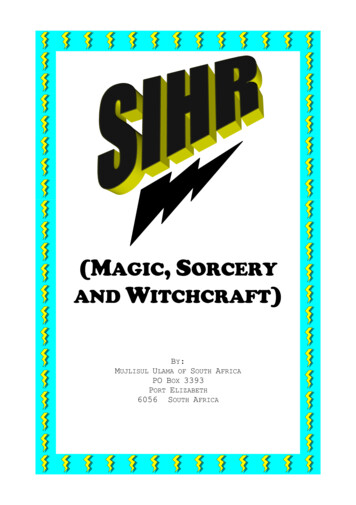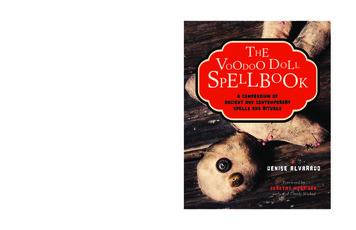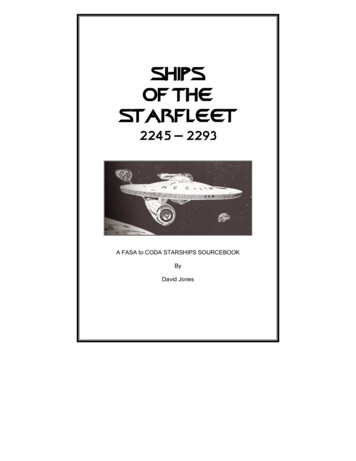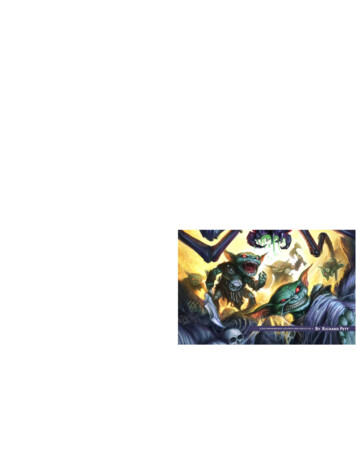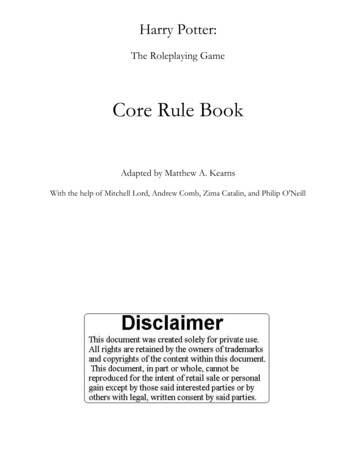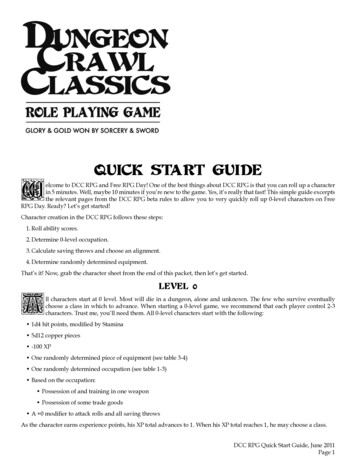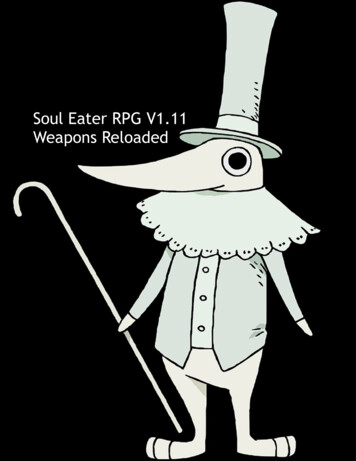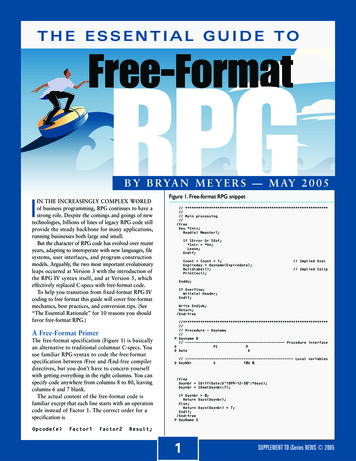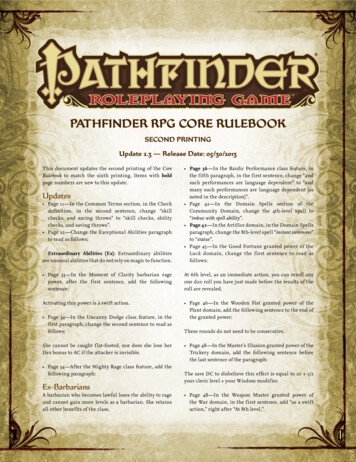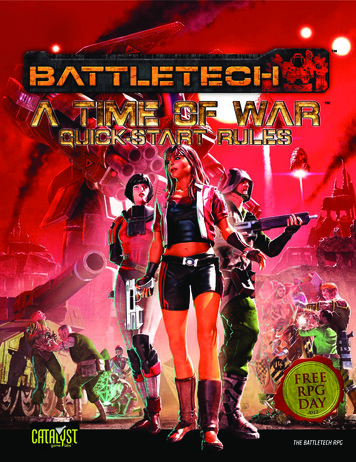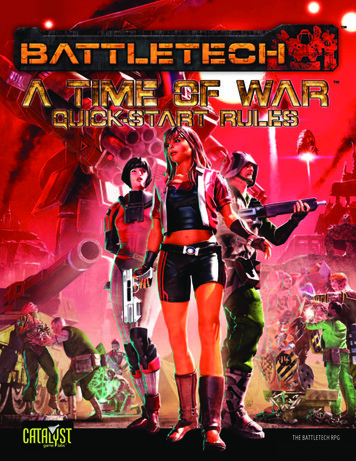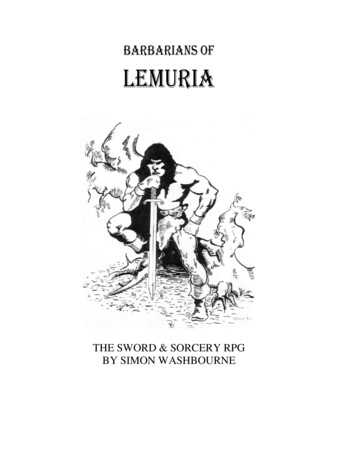
Transcription
THE SWORD & SORCERY RPGBY SIMON WASHBOURNE
Half a million years ago, on the lost continent of Lemuria in the Pacific, the firstcivilizations arose from the red murk of barbarism. For thousands of years the firstmen had struggled heroically to overcome the Dragon Kings - a cruel reptilian racewhich had ruled the Earth during the Age of Reptiles, but at last The Thousand YearWar was done and the Dragon Kings were destroyed or driven from the land.And so began Nemedis, the first kingdom. Over the centuries her children spreadslowly throughout the vast, untamed jungle-lands and across the huge mountainranges of prehistoric Lemuria and kingdoms were founded. and fought. and fell.But with enormous slowness civilization began to grow and before long the first greatEmpire would unite these tiny warring Kingdoms into one mighty power.It was an age of warriors, when brave men and beautiful women, savages and savants,wizards and champions struggled to carve a red path that led to the Throne of theWorld. It was an age of legends and heroic sagas too.And this is one of them.Lin Carter, Thongor and the Wizard of Lemuria“ Greatness came upon Patanga the City of the Flame in the days after Zaar of theMagicians was whelmed and trodden down in ruin beneath the Unknown Sea; and inthe fullness of time six proud cities came to stand under the black-and-gold banners ofThongor the Mighty and lo! the Gods were pleased. But that grim and unappeasableFate thet triumphs even over the gods and is not swayed by the splendour and powerof kings, smote the Warrior of the West with the strangest of dooms, and the jaws ofdeath gaped wide to engulf his unconquerable spirit ”Lin Carter, Thongor at the End of Time1
Barbarians of Lemuria is a heroic role playing game set firmly in the swords & sorcerygenre. Lemuria is a pre-historic world that predates ours by millions of years. It is aland of humid steaming jungles, vast untamed wildernesses, danger-filled swamplandsand hot dry deserts. All manner of massive man-eating beasts roam the unexploredregions of Lemuria and beyond, from the islet-sized sea-serpents capable of sinkingwar-galleys to the huge jungle-dwelling dinosaurs that can swallow a man whole as anappetizer for bigger game.In this harsh world are sprawling cities, teeming with merchants and tradesmen,farmers and hunters all plying their trades in the squares and plazas, bazaars andwharfesides under the shadow of the city walls and great palaces or temples andtowers that have been built to house the nobles and soldiers, priests and wizards of thelands and to safeguard those within from the dangers without.Dotted around the untamed regions are the ancient ruins of temples, cities, tombs andpalaces toppled and cracked, choked with weeds and undergrowth, lying untouchedand awaiting discovery for the vast treasures that remain within their shadowed hallsand empty corridors.It is a place of sagas and legends, epic and myth. Thongor, the heroic ValkarthianBarbarian created many of these sagas by his deeds and adventures. Lemuria is amighty continent and there are plenty more adventures to be had and legends to becreated!The genre is a very specific one - characters are much more stereotypical than in otherfantasy settings - Heroes are all muscle-bound barbarians from the ‘Frozen Wastes’,females are all voluptuous, scantily-clad beauties and the bad guys are typically evilNecromancers and Druids from the ‘Dragon Isles’ or the Old Cities of the East.The main characters are never of the ‘goody two shoes’ variety out to save the worldfrom the minions of evil, they simply look out for themselves although this usuallymeans in their own simple way they ‘do the right thing’ in the end in any event. Theyare never inherently evil - that is the role of the villains or npc’s.The Heroes are always eager for adventure, which comes their way often, especially ifthere is a fortune to be made. Fortunes often fall into the hands of the Heroes, but thewealth is quickly lost again through gambling, drinking, wenching, theft, stupidity orwhatever. Heroes never dwell on their misfortunes for long though. As long as theyhave a good sword in their fists, food in their bellies and a few coins in their pouchesthey are generally satisfied.Heroes are first and foremost warriors and when times are hard will seek employmentas soldiers, mercenaries, sailors or caravan guards to get by, often rising rapidly tohigher positions as a result of their prowess. When nothing else is available they willoften turn their hands to other, less honest, work -picking pockets, burglary, banditryor piracy being favoured by Heroes who have hit 'hard times'although they do tend toprefer honest work when they can get it. However Heroes can only stand their jobs forso long and sooner or later the yearning for adventure will come over them. Luckily itis never far away.2
Barbarians of Lemuria uses a very simple set of rules intended to fit in with the verysimple philosophy of the genre as a whole.It is very easy to play Barbarians of Lemuria completely dice-less as the rules havebeen developed with the idea of keeping the game flowing to match the fast heroicstyle of action of the books upon which the game is based.Essentially the system is based around the idea of careers. A Hero may have manycareers throughout his life - he may have started as a Barbarian from the Northlands,then he may have done some thieving in the City States followed by a short spell as amercenary captain and then on to command a pirate ship on the Seventeen Seas.BoL uses this concept and all player Heroes get to choose 4 Careers at which theyhave little ability (rank 0), much ability (rank 4) or somewhere in between (ranks 1 to3). These careers are the key to what the Hero knows and can do. They determine hisskills and abilities and combined with the four attributes determine whether the Herocan successfully complete a task or not.Although the player can attempt to persuade the GM that a certain career will aid atask attempt the GM is the final arbiter. For example a Hero with Rank 1 as anAssassin is likely to know something about poisons so the GM would allow the playerto add his Rank as an Assassin to the die roll (based on his Mind rating) to recognize apoison in a drink. However being an Assassin would not help the Hero to track aZulphar through the Jungles of Chush although being Ranked as a Hunter would.3
First distribute 4 points between the following four attributes:STRENGTH – this represents raw physical power, toughness, muscle and so on. It isuseful for Heroes who like to bash down doors rather than use the handle or smashopen chests rather than pick the lock.AGILITY – this attribute covers general speed, dexterity and so on. Many thieves,tumblers and archers will have higher than average agility.MIND – intellect, willpower, knowledge and psyche are aspects of the Mind. Usefulfor Magicians, Priests and Scribes.APPEAL – overall looks, charm, persuasiveness and likeability. Merchants, Minstrelsand Serving Wenches will often be strong in Appeal.The minimum in each attribute is 0 and the maximum is 4. Obviously a Hero with a 4in one of his attributes will have 0 in the rest of them.0 is average for ordinary non-heroes (npc’s).Once attributes have been determined then the Heroes combat abilities need to befound. Again the player has 4 points to allocate amongst four areas with a maximumof 4 to one of those areas.4
The combat abilities are:BRAWL – hitting people with fists, feet, head as well as throttling, holding andthrowing people around. Includes the use of improvised weapons, chairs, bottles,tables and so on. Tavern brawls are common in Lemuria and Heroic characters oftenhave some brawling ability. Having said that, a brawl in a Lemurian tavern will oftenlead to the flash of blades and this is where the next combat ability becomes useful.MELEE – this is the skill with hand-held weapons. Swords, knives, clubs, axes andspears are all covered under this heading. Adventurers usually need to be able todefend themselves; Heroes always need to. The skill is normally used to attackopponents, but can also be used to parry blows aimed at you. When your enemy is faraway however, the following combat ability might be worth having.RANGED – hitting targets with bows, crossbows, slings as well as throwing weaponslike spears and knives. Many heroes neglect this skill because it could be consideredun-heroic to kill one’s enemy from a distance. However, considering the beasts thatroam the Lemurian jungles and deserts, most adventurers would consider it wise tohave a means of keeping them at bay. When all else fails, there is of course the nextcombat ability to consider.DEFENCE – Call it dodging, ducking or sidestepping, defence is the skill at beingable to avoid all of the above. Most heroes believe it is better to kill your enemybefore they have a chance to hit back, but other adventurers are a little more safetyconscious and may live a little longer, even if the sagas don’t mention them so often.5
Next the player chooses four Careers for his Hero. A minimum of 0 may be placed andagain the maximum is rank 4. The Career choices are:ALCHEMIST – The scientists and inventors of Lemuria, these characters are oftenmistaken for wizards by those who do not understand science. Skills covered arethings like making potions & perfumes, plant lore, poisons, medicines, metallurgy,distilling urlium (lighter-than-air-metal) for floaters (flying boats) etc.ASSASSIN – These covert killers are adept at sneak attacks, killing, informationgathering, city lore, persuasion, lockpicking and tend to have fast reflexes.BARBARIAN – These characters are not from the cities of Lemuria, but from the RedForests, Valkarthan Northlands or other wildernesses of the continent. They havenatural skills in wilderness lore, living rough, berserk rage, riding, intimidation,natural instincts and so on.BLACKSMITH – Often found helping Alchemists build their inventions, thesecharacters are skilled at weapon & armour making & repair, metallurgy, weapon lore,and can trade for weapons & armour.FARMER – A farmer character lives outside the city, but often within a days travel,so that they are able to get their produce to the city to feed the populace. They areskilled in basic plant & animal lore, animal handling, cooking, trading for basic goodsand such like.GLADIATOR – Often forced into life of professional arena fighters, the Gladiator isskilled in one-on-one tactics, exotic weapons, weapon lore, initiative and weapontraining.HUNTER – Rugged outdoor types skilled in wilderness lore, living rough, trapping,tracking, stealth and other similar pursuits.MAGICIAN – astrology, astronomy, ancient lore, sorceryMERCHANT – trading, persuasion, city lore, knowledge of distant places, guildmembershipMINSTREL – singing, instruments, performing, ancient legends, fast talk, city loreNOBLE – credit, high-ranking contacts, bribery, dress sense, etiquette, authorityPHYSICIAN – medicines, plant lore, first aid, literacy,PIRATE – sea lore, navigation, boat handling, knowledge of far portsPRIEST/DRUID – ancient lore, sorcery, astrology, astronomy, authoritySERVING WENCH – seduction, city lore, carousing, picking pockets6
SCRIBE – ancient lore, ancient languages, map makingSLAVE – humility, going unnoticed, listening, sneakingSOLDIER – city lore, intimidation, riding, authorityTHIEF – city lore, burglary, sneaking, picking pockets, guild membershipTORTURER – getting information, intimidation, medicines, 2-handed axesIn Lin Carter’s Lemuria Saga, Thongor was initially a Barbarian from the Northlands.He came south and became a Thief, a Gladiator, a Pirate, a Soldier and at the end, aNoble. Many of the characters he meets along the way have several aspects to theircharacter. Sharajsha is a Wizard, Alchemist, Scribe and Physician (and probably otherthings too).Choosing the four Careers gives a player an immediate handle on his character. A highRank in a Career could be indicative of a long period of time spent in that position anda Rank of 0 could mean only a short spell or even just a natural affinity for the Career.The Careers skills give a general knowledge of anything to do with the Career, such aswho hold high positions within the profession, where to find the Guilds and who headsthem, skills and abilities that members of the profession should have as well as helpingthe Hero obtain employment in the profession.The list of skills or abilities alongside each career isn’t exhaustive. There are noindividual skills as such in this game. It is intended only to be a guide as to the type ofthings that Career should help you with. If you can convince the GM that your Careercould be helpful in other areas explain why or how and the GM may agree and giveyou a bonus.7
This represents how much punishment and wounding a Heroes body may absorbbefore the Hero keels over. It is based on a value of 10 plus the Strength attribute ofthe character.If, as a result of wounds received the value falls to 0 the Hero falls unconscious. Ifwounds go below this figure the Hero will die.Npc ‘extras’ have only 5 hit points.Importatant npc’s are generated by the GM as Heroes are and will have 10 or more hitpoints, depending upon their Strength attribute.Barbarians of Lemuria is a game of heroic sagas. Player characters are the Heroes ofthese sagas. In the books, Thongor always looked like he was down and out but healways came back, whatever the odds. Hero points are an integral part of the game andshould be used freely as a major element in the game. Use them. There will always bemore for later sagas.Heroes have 5 Hero points to start the game with. These are used during the course ofadventures ‘to dig deep’ and do Heroic (or lucky) things. Spend a point per pointneeded to succeed where otherwise the Hero would have failed in an action or task. Touse it though, the player must describe the Heroic way his character suddenly finds theway or will to succeed. He could simply dig even deeper, scream an oath to his God,get a lucky break etc.Hero points can always be used to keep a Hero alive where he would otherwise bekilled (as long as you have sufficient Hero points). They cannot be used to bring theHero above 0 Hit points, but they can be used to bring a Hero up to 0 – alive butunconscious.At the end of a Saga, the GM will award further Hero points, depending on how theadventure went, how Heroic the characters were, how they defeated their opponentsand the riches they found and so on. Normally, there will be 5 Hero Points awarded,simply to replace those used. If you didn’t use any, you don’t get any extra. In otherwords the points are simply ‘replenished’. Any extra points are lost over and above 5.However, if the Saga went badly, then the GM might award a point or two less. In thiscase a character who has 1 Hero Point left at the end of an adventure which went badlyis awarded only 3 Hero Points. He will have only 4 Hero Points for his next adventure.As a reward for good role-play, there will be an extra point awarded for exceptionalrole-play (as a group or to individual characters). However this extra point is anadvancement point. It is used specifically to advance either; an Attribute, CombatAbility or Career. The point is spent immediately it has been awarded. Advancementpoints can be used to take Attributes, Combat Abilities and Careers above 4.8
To perform a task, the player simply rolls two dice (2d6) and adds any appropriateAttribute levels together with an appropriate Combat Ability if in combat, or CareerRank if not. If there are any modifiers (determined by the GM) these are factored inand if the resulting total is 9 or greater the task was anPoint blankCloseMediumLongDistantExtreme 10-1-2-3-4Krongar the Mighty, a Northern Barbarian with a StrengthAttribute of 4 is attempting to break down a door, whichhe is sure blocks his way to a vast horde of treasure. TheGM decides that Krongar has no Careers that would behelpful to the task in hand and has already predeterminedthat the solid door will be a difficulty of Hard, or –1. Soplayer of Krongar needs to roll a 6 or greater on 2d6 to bash open the door.Assuming our Hero gets through the door, rather than finding hidden wealth he finds agreat pit and, having smashed through the door, he finds he is hurtling towards it.Attempting to leap the pit is an Agility task, and Krongar has a 0 in this attribute.Luckily the GM is in a good mood and decides that his natural Barbarian instincts willcome into play and allows the player to add Krongars’ Barbarian Rank of 2 to the diceroll. The dice come up 8 and with the 2 gives a total of 10, meaning that Krongar isacross the pit and heading for even greater adventure.9
Combat is dealt with in rounds of a few seconds or so in length. In that time acharacter can fire a bow, strike or parry with a weapon, throw an axe and so on. Thecharacter involved in the combat with the highest Agility Attribute goes first. In thecase of a tie, the highest Combat Ability for the option being used gets to go first. Inthe event of a tie, the one with the highest and most appropriate career goes first.Combat resolution is similar to Task resolution. Rather than adding a Career to theappropriate Attribute level though, the most appropriate Combat Ability level isadded.The required roll is still 9 or more, but this time in addition to any GM determinedmodifiers (which could be due to range for thrown or fired weapons, or for hitting anenemy from behind and so on) the opponents’ defence rating also becomes a modifierto the roll needed to hit.The GM could allow, in some rare circumstances, a Career to provide an additionalbonus. For example, Assassins may be allowed an additional bonus when strikingunaware enemies, or Gladiators may be allowed to make special maneuvers whichcould give them a slight edge over an opponent and so on.Krongar is standing on the far side of the pit, when through the door he has justdestroyed comes a guard with a crossbow. The guard fires at the intruder. His RangedCombat Ability is 0 as is his Agility, and the referee decides the shot is at close rangefor a difficulty of 0. Krongar has a defence of 1 and so the guard requires a 10 or moreto hit.Heroes may elect to dodge or parry. If they do this they get no attack for the round but,in the case of a dodge, get double the normal defence (a minimum of 1 for those with0 defence) for all attacks directed at them.In the case of a parry, they get to roll using their Melee Ability and Agility and if theyget a 9 or more the blow is blocked.So in our example above if Krongar elects to dodge his effective Defence will be 2,meaning the guard needs 11 to hit him. However, Krongar could do nothing else in thecombat round.10
When a hit has been done on an opponent a degree ofdamage or wounding is likely to be the result. Thebigger the weapon the nastier the wound is likely to be.Luckily there is also armour available to absorb someor all of the effect of such blows. However, shields areuncommon in Lemuria.The weapon table below shows the damage dice doneto the Hit Points of the victim when a blow lands. Inaddition to the damage shown add the Strength of theattacker as strength helps the blow do more severeharm.The armour table shows how much of the blow isdeflected and or absorbed. This is the protection of thearmour and takes into account the material as well asbody coverage.11
Thongor never went shopping. Neither should characters in Barbarians of Lemuria. Ifa player wants his character to have something that would be appropriate to his career,let him have it. If he wants something less appropriate you can still let him have it.You can always take it away from him!He is a Soldier – let him have armour and a couple of weapons. He is a Barbarian - lethim have a necklace of bear’s teeth, some javelins, a wineskin and a sword. She is aWench – let her have a knife, some fancy clothes and make-up. He is a Magician - lethim have some rings and amulets, a fancy robe and a skull-topped staff. He is a Noble- let him have a palace in Patanga and a galley in the port.I have not included any costs for the simple reason that characters can have what theywant and what would be reasonable for their career. Think of it this way. What use is apalace in Patanga, when you are lost in the Jungles of Chush armed with only a swordin your tired fist?Heroes only go around with what they can reasonably carry. They live for the day.You never know what you will need on adventure and you can’t take everything, sowhy bother? Use your Hero Points instead. That’s what they are for.If you want backpacks full of and adventuring gear, a weapon for every occasion,three spare suits of armour and a pack animal to carry it all around on then playanother game. If all you want is a breech-clout and a sturdy blade, play on!FistDaggerSwordAxeClubMaceSpearFlail2 hand 6d4d6d82d61342435631346*Requires 4 Strength to use.Fist: This is used to punch people. It represents the use of elbows, feet, head and soon.Dagger: This covers all forms of short stabbing, thrusting or slashing weapon, either12
with one or two edges, that can be thrown or used in close quarters. Highly conealableit is a favourite of rogues and assassins.Sword: This is the catch-all description for all manner of long-bladed, one-handedweapons used all over Lemuria, such as cutlasses, tulwars, scimitars, rapiers,broadswords and longswords.Axe: One-handed axes, usually with iron heads on a wooden haft. Can be one or twobladed.Club: The simplest of all weapons, this is a length of wood, used in one hand to cluband batter your opponent.Mace: Similar to a club, but with a metal head, often with spikes or flanges.Spear: A 5 to 6 foot length of wood with a pointed tip, designed for throwing or forusing against mounted opponents in particular.Flail: A shaft of wood, mounted by a length of chain with a spike-ball head. Not toocommon on Lemuria, but can be found in gladiatorial arenas.2 handed weapon: This covers any weapon requiring two hands to use, from the greatswords of Valkarth, great axes, great maces, long spears, halberds and so on.Staff: A simple stout pole of around 6’ in length, used as an aid to walking and aneffective weapon.Sling: A simple leather thong whirled around the head to cast small stones with someforce.Bow: represents a wide variety of weapons, which are used to fire arrows by drawingback the bowstring which is strung between the two ends of a curving length of wood.Crossbow: A simple device for firing a short quarrel with some force and littletraining.Warbow: The mighty bow of the Blue Nomads. Requires great strength to draw thestring.Gauntlets1Bracers1Boots1Greaves1Battle Harness 1Chain Bikini 1Leather Coat 2Mail Shirt3Plate Cuirass 4Helm or coif 1Full Helm2Small shield *Large shield *223233581223310Heroes tend to wear little in the way of armour often notfor practical reasons but out of vanity (armour covers toomuch of their bronzed bodies). As it happens Lemuria isvery hot, and so that is another good reason not to wear toomuch armour. If more than one type of armour is worn,simply add the protection values of all the armour together.13
Shields are different. They are quite rare in Lemuria, although some city guards dohave them. They give the user a defence rating, where that person would otherwisehave no defence. Small shields provide a defence rating of 1 and large shields providea defence rating of 2. If your character already has a defence of 1, then only a largeshield can improve this and then only to 2.Shields are useless to heroes with defence ratings of 2 or higher. They just get in theway. They are really designed to protect ordinary soldiers a little.Gauntlets: Heavy leather gloves, perhaps with metal studs or strips. May not be wornwith bracers.Bracers: Hardened leather or metallic forearm protection. May not be worn withgauntlets.Boots: Heavy leather boots providing protection up to the knees. Not a common itemon Lemuria, though the sailors and pirates wear them more often. May not be wornwith greaves.Greaves: Hardened leather or metallic shinguards. May not be worn with boots.Battle Harness: A broad leather crossbelt buckled across the chest and used to attachweapon scabbards, arrow quivers and so on. As a result of the amount of leather, metalbuckles and so on, the battle harness makes for decent protection and many heroes willsimply wear one of these due to the hot climate and in order to show off their manlyphysiques. May be worn over other types of armour, though this would be excessivelycumbersome and hot, not to mention unheroic.Chainmail Bikini: To the female Hero what the battle harness is to the male. It isexactly as it sounds - a collection of mail links covering only the barest minimum ofthe body, allowing a feast for the eyes of any Hero in the vicinity. Not normally wornwith other body armour although greaves and bracers are often worn with one.Leather Coat: A coat of thick leather or thinner leather with metal studs or similar.May be worn under a plate cuirass, though Heroes would rarely do so and besides aperson in all this garb would sweat like a bouphar in the heat of the Lemurian sun.Mail Shirt: Heroes sometimes wear these in battle. They are simply metal linkspieced together to form a shirt or tunic. Offers light flexible protection. Not usuallyworn with other body armour.Plate Cuirass: A breastplate and backplate of shaped metal. Quite restrictive and canget very hot. Heroes tend to avoid these when adventuring although they might wearone in a battle.Helm: A simple helmet of hard leather with or without metal studs.Coif: A hood of metal links. Can be worn under other helmets but gets very hot.Full Helm: A heavy metal helmet with nose, ear and cheek guards. Cumbersome andrestrictive.Shield: Usually made of wood, with perhaps a hide covering and metal boss, it strapsto the forearm and has a handle for maneuverability. About 18” in diameter for smallshields and maybe 2’ or more in diameter for larger ones.Krongar, in our example above is hit by the crossbow bolt fired by the guard. Krongaris wearing his battle harness (1 point of protection), boots (1 point) and bracers (1point) for a total of 3. A crossbow bolt does d8 points of damage and the GM rolls 514
for the guards’ shot. There is no Strength bonus as the guard is average. Of the 5points 3 are absorbed by Krongar’s armour and so Krongar receives 2 wounds againsthis Hit Point total of 14, reducing him now to 12.Krongar, in anger throws his own spear at the guard, requiring a total of 7 to hit(Krongar has a Missile combat rating of 2 and no Agility bonus and there are no rangemodifiers) and does so. Damage is d6 for the spear, but 4 for Krongars'Strength andthe dice comes up 5 for a total of 9. The guards’ armour (leather) stops 2 points but the7 wounds received still does enough to reduce his wound level to -2 and kill him.15
The Wizard was old – how old Thongor did not venture to guess, but the stamp ofcenturies was in his lined face. He wore a long wide-sleeved robe of neutral grey andabout his middle was a girdle of serpent-leather, from which a short-sword of peculiardesign and a pouch of scarlet photh skin hung. Upon his slim artistic fingers he woremany sigils and talismanic rings. One was of iron, graven with wedge-shaped runes.Another was of blood-red jade, embossed with a name of power. The rest werefashioned of stones, metals and queer woods. With these rings, Thongor suspected, theWizard could summon and command spirits and elementals”.Thongors meeting with Sharajsha in The Wizard of Lemuria.Characters with points in the Magician Career begin play with 10 plus their MagicianCareer level in Spell Points.Magicians always have rings and trinkets about their bodies through which they cancast very minor and simple tricks and cantrips. Maybe making a ring glow to providelight, or a talisman that can make a tiny object invisible for a minute or a bracelet thatcan make a small plant or creature wither and die. What constitutes a simple cantrip isup to the GM, but you need not have them prepared in advance, you simply need totell the GM what you wish to do and provided he is in agreement then the spell is cast(no roll normally needed). These tricks do cost a spell point to power though.More powerful spells are trickier though and are really the stuff of Heroic Magiciansand Evil Sorcerors. Each spell has a difficulty (see Task Resolution) based on theGM’s assessment of the player’s desired effect ranging from Hard to Herculean.Casting a spell costs 4 spell points. It will cost 1 less spell point for each of the ‘prices’that the Magician has paid, with a minimum of 1 spell point. Failure always costs 4spell points no matter what.In other words, if the Magician has paid three of the ‘prices’, the Magician can cast hisspell for the cost of only 1 spell point, but with only two the cost is 2 spell points andwith only one the cost is 3 spell points and with none, the cost is 4 spell points. Ancient tome, heavy tablet or delicate scrollA personal item of the target that must be acquiredIntimate knowledge that must be acquiredLine of sightRare ingredients: 1d6 weeks and 2d10 gold to acquireTime to cast: 1d6 x 30 minutesTime to cast: 2d6 hoursA favourable alignment of stars or planetsExactly the right time of dayThe right day of the yearEither the player or the GM or both specifies the three necessary elements and rolls thedice as described below. A failed spell roll generally results in curses, demonic16
possessions, explosions and other similar unpleasantness as well as the loss of 4 SpellPoints.Magician PCs already know one spell per point invested in the career. Acquiringad
3). These careers are the key to what the Hero knows and can do. They determine his skills and abilities and combined with the four attributes determine whether the Hero can successfully complete a task or not. Although the player can attempt to persuade the GM that a certain ca
